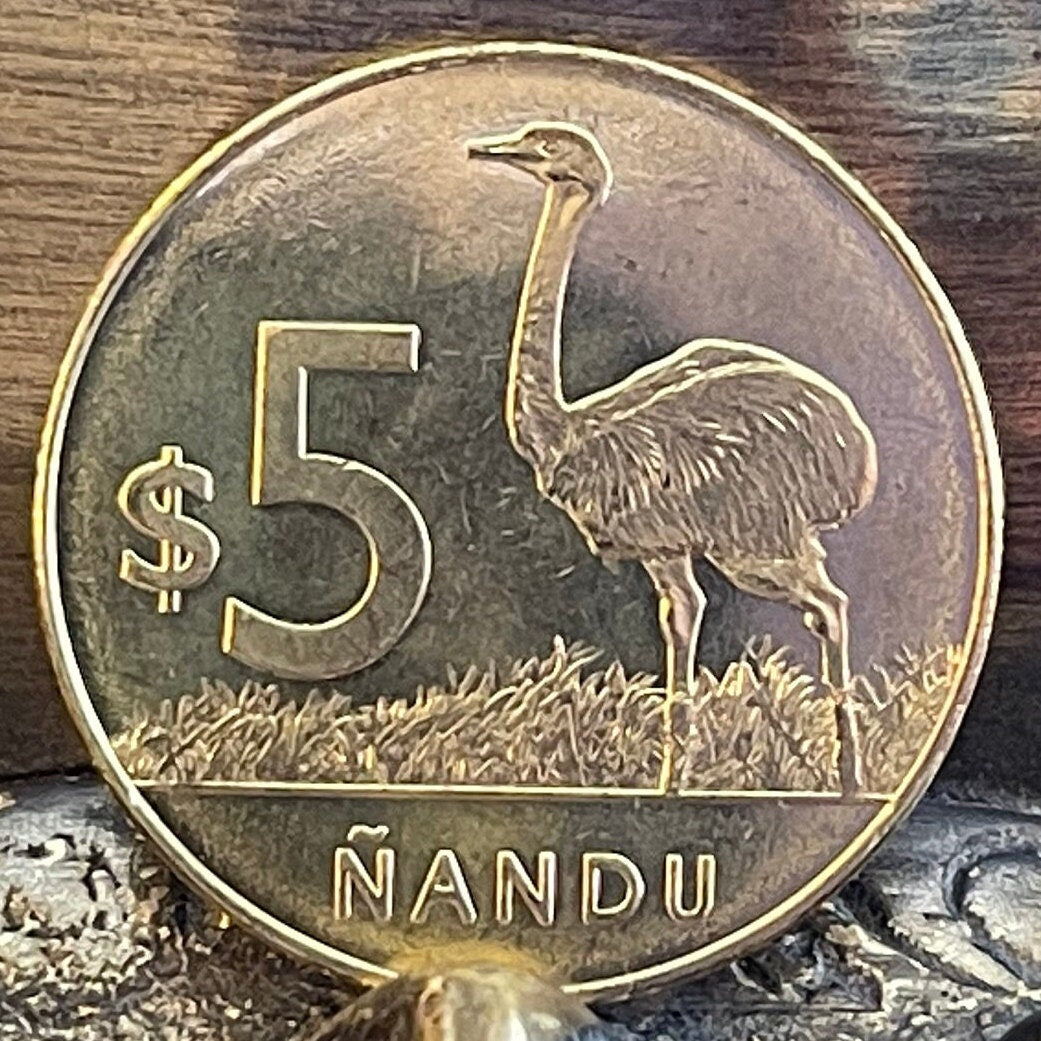elemintalshop
Greater Rhea 5 Pesos Uruguay Authentic Coin Money for Jewelry and Craft Making (Ñandu) (Ratite)
Greater Rhea 5 Pesos Uruguay Authentic Coin Money for Jewelry and Craft Making (Ñandu) (Ratite)
Couldn't load pickup availability
Greater Rhea 5 Pesos Uruguay Authentic Coin Money for Jewelry and Craft Making (Ñandu) (Ratite)
Commemorative issue: Rhea
Series: Native fauna of Uruguay
Reverse: Rhea Americana (Ñandu) to left, face value on left side, animal name (in Spanish: Ñandu) below.
Lettering: $5
ÑANDU
Translation: $5
Rhea
Obverse: Coat of arms, name of the country around, date on bottom
Lettering: REPUBLICA ORIENTAL DEL URUGUAY
Translation:
Eastern Republic of Uruguay (Uruguay)
Features
Issuer Uruguay
Period Oriental Republic of Uruguay (1825-date)
Type Circulating commemorative coin
Years 2011-2019
Value 5 Pesos Uruguayos
5 UYU = 0.12 USD
Currency Peso uruguayo (1993-date)
Composition Brass plated steel
Weight 6 g
Diameter 26 mm
Thickness 1.8 mm
Shape Round
Orientation Medal alignment ↑↑
Number N# 22259
References KM# 137
Wikipedia:
The rheas (/ˈriːə/) are large ratites (flightless birds without a keel on their sternum bone) in the order Rheiformes, native to South America, distantly related to the ostrich and emu. Most taxonomic authorities recognize two extant species: the greater or American rhea (Rhea americana) and the lesser or Darwin's rhea (Rhea pennata).
The name "rhea" was used in 1752 by Paul Möhring and adopted as the English common name. Möhring named the rhea after the Greek Titan Rhea, whose Ancient Greek name (Ῥέα) is thought to come from ἔρα "ground". This was fitting with the rhea being a flightless ground bird. Depending on the South American region, the rhea is known locally as ñandú guazu (Guaraní, meaning big spider, most probably in relation to their habit of opening and lowering alternate wings when they run), ema (Portuguese), suri (Aymara and Quechua), or choique (Mapudungun). Nandu is the common name in many European languages.
Rheas have many uses in South America. Feathers are used for feather dusters, skins are used for cloaks or leather, and their meat is a staple to many people.
Gauchos traditionally hunt rheas on horseback, throwing bolas or boleadoras—a throwing device consisting of three balls joined by rope—at their legs, which immobilises the bird. The rhea is pictured on Argentina's 1 Centavo coin minted in 1987, and on the Uruguayan 5 peso coin.
********
Wikipedia:
The coat of arms of Uruguay or Uruguayan shield (Spanish: Escudo de Armas del Estado) was first adopted by law on March 19, 1829, and later on had some minor modification in 1906 and 1908. It was supposedly designed by Juan Manuel Besnes Irigoyen (1788–1865).
Description
It consists of an oval shield, which is divided into four equal sections and crowned by a rising golden sun, the “Sun of May”, symbolizing the rising of the Uruguayan nation and the May Revolution. The oval is surrounded by a laurel branch on the left and an olive one on the right, representing honor and peace, joined at the bottom by a light blue ribbon, the former Uruguayan cockade.
In the upper left quarter there is a golden scale on a blue background, symbol of equality and justice.
The upper right quarter contains the Cerro de Montevideo (Montevideo Hill) with its fortress on top on a silver background, as a symbol of strength.
In the lower left, also on a silver background, there is a galloping black horse, symbolizing liberty.
The lower right quarter holds a golden ox on blue background, as a symbol of abundance.
Share










My coins arrived quickly and were well packaged. The coins were in great condition.
What a great resource for coins from around the world! Amazing!
This is a nice coin in great condition and delivery was fast.









